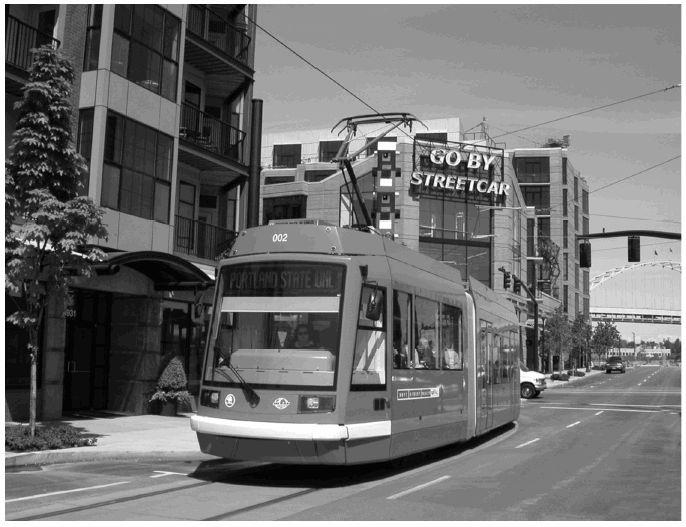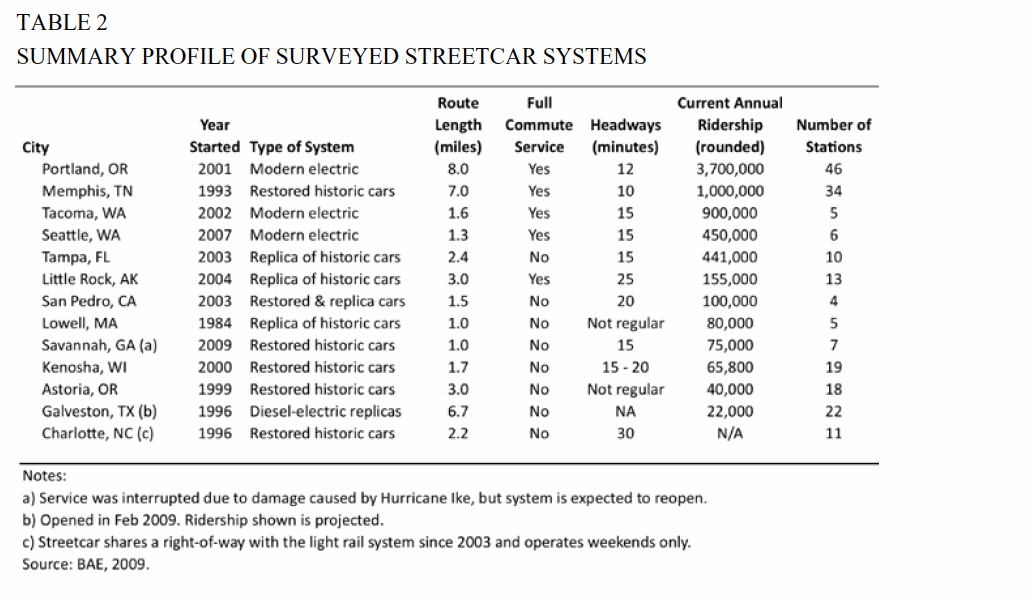TRANSIT COOPERATIVE RESEARCH PROGRAM
INTRODUCTION
Background
In the past 20 years, numerous cities have planned and implemented new rail transit systems. This movement has coincided with other urban regeneration trends, bringing new life to urban centers and advancing strategies to manage growth that promote more efficient patterns of development. Various forms of heavy rail, light rail, and streetcar systems have been built, many with robust ridership and popularity, owing to a rediscovery of this form of transportation, as well as concerns about growing traffic congestion, volatile fuel prices, and climate change.
One of the types of rail under consideration or built by numerous cities is the streetcar, reviving an older form of urban transportation. At present, more than 45 streetcar systems are either built, under construction, or planned across the United States, ranging from larger cities such as Columbus, Ohio, to smaller cities such as Winston-Salem, North Carolina; Pasadena, California; and Lake Oswego, Oregon. Streetcar systems have gained in popularity because of their relatively lower cost of construction than light or commuter rail, the ease of integrating streetcars into the existing urban fabric, and the convenience of frequent stops (see Figure 1).
The most showcased modern streetcar system in the United States is the Portland streetcar. Opened in 2001, the system has grown to more than 4 mi of track traversing downtown, and currently is in the final design stages of an additional 3.3-mi extension from downtown Portland across the Willamette River. The success of this system, and its relationship to further enhancing the Portland region’s extensive network of light rail lines, has made Portland a leader in public rail transit.
The streetcar “renaissance” has brought a strong desire by policymakers and planners to gain a more in-depth understanding of how this form of transportation interacts with the built nvironment. This report provides a synthesis of published literature on this topic, as well as a summary of a survey of 13 streetcar systems recently built or expanded to identify impacts on the built environment.
PURPOSE OF SYNTHESIS
The purpose of this synthesis is to document experience with selected streetcar and trolley projects and their relationship with the built environment. Local potential for changes in land use are often used to justify investment in streetcar and trolley systems. However, the ability of these systems to spur growth and revitalization has not been documented adequately. Questions remain regarding the direct role of such systems on the built environment versus other factors that also may be important.
In documenting experiences, this synthesis examines selected, built streetcar and trolley systems to trace their evolution, define significant factors, and identify commonalities among levels of success in affecting the built environment.
…
APPROACH TO SYNTHESIS
To clearly focus this synthesis on the impacts of streetcars on the built environment, distinct from light rail, and also to draw meaningful findings with respect to the unique qualities of streetcars’ impacts, this report focuses on recently built streetcar systems (i.e., developed within the past 20 years).
Hence, systems in Boston, New Orleans, Philadelphia, and San Francisco are not evaluated in this synthesis for their impacts on the built environment. These legacy systems have been in operation for decades and the built environments along the streetcar routes has evolved over the course of decades throughout the 20th century.
The following list of 14 currently operating U.S. streetcar systems are the focus of this synthesis:
1. Astoria, Oregon
2. Charlotte, North Carolina
3. Dallas, Texas (M-Line)
4. Galveston, Texas
5. Kenosha, Wisconsin
6. Little Rock, Arkansas
7. Lowell, Massachusetts
8. Memphis, Tennessee
9. Portland, Oregon
10. San Pedro, California
11. Savannah, Georgia
12. Seattle, Washington
13. Tacoma, Washington
14. Tampa, Florida
The Charlotte streetcar system operates weekends only on a right-of-way shared with the light rail system. Service on the Galveston streetcar system was interrupted because of damage caused by Hurricane Ike, but the system is expected to reopen.
Initial consideration of the diversity of existing streetcar systems highlights a wide spectrum in the level of service that is being offered in terms of routes, hours and days of service, and the types of users being served. This includes “fuller service” systems (Memphis, Portland, Seattle, and Tacoma) that operate 7 days a week year-round, offer service throughout commute hours, and have longer routes enabling them to serve as urban circulators or multiple routes. At the other end of the spectrum, “shorter service” systems (Astoria, Charlotte, Galveston, Kenosha, Lowell, San Pedro, Savannah, and Tampa) operate fewer hours excluding at least one commute period (typically mornings), offer less than daily service, or have a seasonal schedule. Many of these systems are more oriented toward serving tourists than the full range of transit trips, and they include a number of systems that use heritage vehicles or replicas of them. Other systems (Dallas, Little Rock) fall toward the middle of this spectrum.
Streetcar systems that provide a fuller service, and target a broader range of riders, particularly commuters, offer a higher level of transportation amenity and would be expected to generate greater ridership, and potentially a more synergistic effect in stimulating changes in the built environment along their route(s). At the same time, these systems are not static, and as service hours are increased and routes extended, “shorter service” systems can become “fuller service.”
Download full version (PDF): Relationships Between Streetcars and the Built Environment
About the Transit Cooperative Research Program (TCRP)
www.tcrponline.org
“The mobility, environmental, and energy objectives of a growing population and economy calls for public transportation systems in the United States to expand their services and improve their efficiency. Practical research that yields near-term results can do much to help – by solving operational problems, adopting useful technologies from related industries and, in general, finding ways for the public transportation industry to innovate. The Transit Cooperative Research Program is a key instrument for carrying out such useful research. The program places primary emphasis on putting the results in the hands of organizations and individuals that can use them to solve problems.”
Tags: AR, Arkansas, Astoria, CA, California, Charlotte, Dallas, FL, Florida, GA, Galveston, Georgia, Kenosha, Little Rock, Lowell, MA, Massachusetts, Memphis, NC, North Carolina, OR, Oregon, Portland, San Pedro, Savannah, Seattle, Streetcars, Tacoma, Tampa, TCRP, Tennessee, Texas, TN, Transit Cooperative Research Program, TX, WA, Washington, WI, Wisconsin








 RSS Feed
RSS Feed